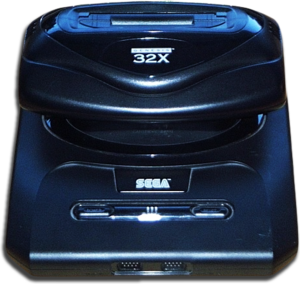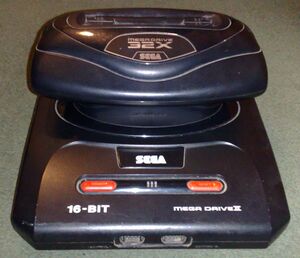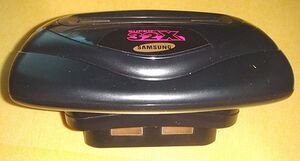Difference between revisions of "Sega 32X"
From Sega Retro
| Line 114: | Line 114: | ||
Image:32x console jp box front.jpg|JP retail box (front) | Image:32x console jp box front.jpg|JP retail box (front) | ||
Image:32x console jp box back.jpg|JP retail box (back) | Image:32x console jp box back.jpg|JP retail box (back) | ||
| + | </gallery> | ||
| + | <gallery> | ||
| + | File:32X BR Box Front.jpg|BR retail box (front) | ||
| + | File:32X BR Box Back.jpg|BR retail box (back) | ||
</gallery> | </gallery> | ||
Revision as of 14:32, 17 September 2010


The Sega 32X (Japanese: スーパー32X; Romaji: Supa 32X) was an official hardware add-on to the Sega Mega Drive, created and distributed by Sega. In Japan, it was distributed under the name Sega Super 32X. In North America, its name was the Sega Genesis 32X. In Europe, Australia, and other countries that use PAL, it was called the Sega Mega Drive 32X.
Initially released in late 1994, the 32X was designed to extend the capabilities of the Sega Mega Drive (see Enhancements below), but is now seen as a commercial failure. Though the system was more powerful than both the Sega Mega Drive and Super Nintendo Entertainment System, it was both expensive and under-supported, as well as being overshadowed by the Sega Saturn which was released just months later.
The system cannot work by itself. The Sega 32X can only be used in conjunction with a Sega Mega Drive/Sega Genesis system; it is plugged in where the cartridge bay is. Besides playing its own cartridges, it also acted as a passthrough for Genesis games so it would be a permanent attachment. The 32X came with 10 coupons and several spacers, so it would work with all versions of the Genesis.
By the end of its lifespan there were 34 games released for the 32X, five of which received enhanced versions that also require a Sega Mega CD in order to be played (see Sega Mega CD 32X). Romance of the Three Kingdoms IV: Wall of Fire was the only Japanese exclusive game. All 32X consoles have regional lockout chips, meaning that 32X games from one region cannot be played on 32X consoles from a different one, unless the console was modified (though there are some exceptions, such as FIFA Soccer 96.
Enhancements
The 32X brought several visual upgrades to the Mega Drive, including being able to display more colours on-screen (32768 at once, which was an important requirement for games featuring full-motion video and had hence been a common complaint with the Sega Mega CD), enhanced scaling and rotation, and additional 3D graphics capabilities provided by its two Hitachi 32-bit RISC processors.
Audio capabilities were also upgraded, including the addition of QSound technology, which enables multidimensional sound that allows a regular stereo audio signal to approximate the 3D sounds heard in everyday life (similar to binaural recording).
History
With the release of the Super Famicom in Japan and the Super NES in North America, Sega needed to leapfrog in order to catch up to Nintendo in the technological department. The Sega Mega CD (aka Sega CD) hadn't worked as well as Sega wanted it to. The company had various hardware development projects underway, some using System 16 technology like the Sega Mega Drive did, as well as other arcade games.
On January 8, 1994, Hayao Nakayama, then CEO of Sega, ordered his company to make a 32-bit cartridge based console that would be in stores by Christmas 1994. This would at first be referred to under the codename "Project Jupiter", but after Sega found CD technology cheaper, they decided to modify it instead of dropping the cartridge project. Hideki Sato and some other Sega of Japan engineers came over to collaborate about the project with SEGA of America's Joe Miller. The first idea was a new Sega Mega Drive with more colors and a 32-bit processor. Miller thought that an add-on to the Mega Drive would be a better idea, because he felt that gamers would not buy an improved version of the Mega Drive. And so, this project was codenamed Project Mars, and Sega of America was going to shape the project.
The 32X was primarily envisioned as a system which would extend the life of the Sega Mega Drive/Genesis and provide revenue while the installed userbase of the Sega Saturn slowly grew.
The video-gamer public first got a glimpse at the Summer 1994 CES in Chicago, Illinois. The console was unmasked as the 32X, with a price projection of $170, at a gamers' day, held by Sega of America on September 1994. It was released in mid-November 1994 in North America for $150 the same month that the Sega Saturn was released in Japan. It was then released in Japan in December 1994, and Europe in January 1995 for £150.
Only 500,000 consoles had been produced for North American distribution, yet orders were in the millions. Games had been rushed for the system in order to be shipped for the Christmas season and they came with errors in programming. Some games which were ports left out portions which were in the original game. This is evident in Doom as many levels are missing and musical scores are scarce. Many were complaining that their 32X was not working with their Mega Drive/Genesis or television. Sega was thus forced to give away adapters.
Since this was an expensive add-on system, Sega decided to offer a £50 discount on games with the console in Europe. However, the offer came in the form of rebate vouchers which were difficult to take advantage of. Just like its North American counterpart, this console was initially popular. Orders exceeded one million, but not enough were produced, and shortage supply problems arose. Two games, Darxide and FIFA Soccer '96, were only released for the PAL 32X. The Darxide videogame had been awarded "Best 32X Game".
To make matters worse five games were released under the "Sega CD 32X" label, making use of both the Sega Mega CD and 32X add-ons so that they could benefit from CD quality audio and increased graphical capabilities. With all these Sega consoles on the market (Mega Drive, Mega CD, 32X, Mega CD 32X, Sega Saturn, Game Gear and even the Master System) customers were often left confused as to which software would work with which machine/add-on.
By mid-1995 Sega executives realized their blunder and it was too late. Developers and licensees had abandoned this console in favor of what they perceived to be a true 32-bit console, the Sega Saturn. Even though the 32X add-on was a 32-bit system, the games weren't taking the full advantages of systems capabilities. Many games were 2D and rushed or slightly upgraded Mega Drive/Genesis titles. Also, customers perceived the Sega Saturn and the Sony PlayStation as the true next-generation consoles, and abandoned the 32X as doubts had arisen of Sega's promise to support it. Others chose to skip the 32X completely and wait for the PlayStation and Saturn. Store shelves became littered with unwanted Sega 32X systems, and prices for a new one dropped as low as $19.95 in the US. Sega planned a console named the Sega Neptune, which would have been a Genesis and 32X in one. However, by the time a prototype was developed, the Sega Saturn was due for release, and the Sega Neptune project was cancelled.
The system ended production in 1996 worldwide. The last game made for the 32X was Spider-Man: Web of Fire (1996). In the end the system was merely a gap filler between the Mega Drive and the Saturn, but never saw the same level of success as either console. The 32X badly damaged Sega's reputation, which was further tarnished when the Sega Saturn failed to compete with the Sony PlayStation/Nintendo 64. It is often said Sega never truely recovered, and hence ultimately left the console business altogether. The Sega 32X fiasco is now considered one of the most badly planned console releases of all time.
Technical specifications
- Processor: Twin Hitachi SH-2 (SH7095) 32-bit RISC processors with a clock speed of 23 MHZ 40 MIPS
- Co-processors: Overlay Mega Drive Motorola M68000, Zilog Z80, Genesis 32X VDP
- Video: 320x224/320x240 double buffered framebuffer with three modes:
- 8bpp "packed pixel" mode: 256 simultaneous colors on screen; each pixel is an index into CRAM (can use full screen)
- 16bpp "run length" mode: 256 simultaneous colors on screen; each pixel is both a number of pixels to display and the index of CRAM (limits screen size)
- 16bpp "direct color" mode: 32,768 simultaneous colours on screen; each pixel is the color value (limits screen size)
- 256KB VRAM ("DRAM") split into two 128KB segments for each framebuffer. A priority system allows partial overlaying of Mega Drive/Mega CD graphics.
- Memory: 512k (4 MBit) additional RAM to Mega Drive/Sega Mega-CD memory
- Audio: Stereo PWM (Pulse Wave Modulation) mixing with Mega Drive sound; additional 2 channels (therefore 14 all together?)
- I/O: Same as Mega Drive; 32X upgradable; can upgrade the 32X
- Storage: CD-ROM if you have a SegaMega-CD; speed same as Sega Mega-CD compatible with audio CD, CD&G, SegaCD and JVC WonderMega
- Cartridge: compatible with all Mega Drive models, JVC Wondermega can store save game/score information.
Games
Games marked with asterisks(*) are enhanced versions of previous Sega Mega CD-only games, taking advantage of the 32X's improved graphics, which require both the 32X and Mega CD in order to be played (see Sega Mega CD 32X).
- After Burner Complete (1995)
- BC Racers (1995)
- Blackthorne (1995)
- Brutal Unleashed: Above the Claw (1995)
- Corpse Killer (1994)*
- Cosmic Carnage (1995)
- Darxide (1995)
- Doom (1994)
- Fahrenheit (1995)*
- FIFA Soccer '96 (1995)
- Golf Magazine: 36 Great Holes Starring Fred Couples (1995)
- Knuckles' Chaotix (1995)
- Kolibri (1995)
- Metal Head (1995)
- Mortal Kombat II (1995)
- Motocross Championship (1995)
- NBA Jam Tournament Edition (1995)
- NFL Quarterback Club (1995)
- Night Trap (1994)*
- Pitfall: The Mayan Adventure (1995)
- Primal Rage (1995)
- RBI Baseball '95 (1995)
- Sangokushi IV (1995)
- Slam City with Scottie Pippen (1995)*
- Space Harrier (1994)
- Spider-Man: Web of Fire (1996)
- Star Trek: Starfleet Academy Starship Bridge Simulator (1995)
- Star Wars Arcade (1994)
- Stellar Assault (1995)
- Supreme Warrior (1995)*
- T-Mek (1995)
- Tempo (1995)
- Toughman Contest (1995)
- Virtua Fighter (1995)
- Virtua Racing Deluxe (1994)
- World Series Baseball Starring Deion Sanders (1995)
- WWF RAW (1995)
- WWF WrestleMania: The Arcade Game (1995)
- Zaxxon's Motherbase 2000 (1995)
Box Scans
- 32X BR Box Front.jpg
BR retail box (front)
- 32X BR Box Back.jpg
BR retail box (back)
External links
- Console Database - Sega 32X Info
| Sega Home Video Game Systems | ||||||||||||||||||||||||||||
| 83 | 84 | 85 | 86 | 87 | 88 | 89 | 90 | 91 | 92 | 93 | 94 | 95 | 96 | 97 | 98 | 99 | 00 | 01 | 02 | 03 | 04 | 05 | 06 | 07 | 08 | 09 | 10 | 11 |
|---|---|---|---|---|---|---|---|---|---|---|---|---|---|---|---|---|---|---|---|---|---|---|---|---|---|---|---|---|
| SG-1000 | SG-1000 II | Mega Drive | Mega Drive II | |||||||||||||||||||||||||
| SC-3000 | Mega-CD | Mega-CD II | Genesis 3 | |||||||||||||||||||||||||
| Sega Mark III | 32X | Dreamcast | ||||||||||||||||||||||||||
| Master System | Master System II | |||||||||||||||||||||||||||
| AI Computer | Game Gear | |||||||||||||||||||||||||||
| Saturn | ||||||||||||||||||||||||||||
| Pico | Beena | |||||||||||||||||||||||||||














